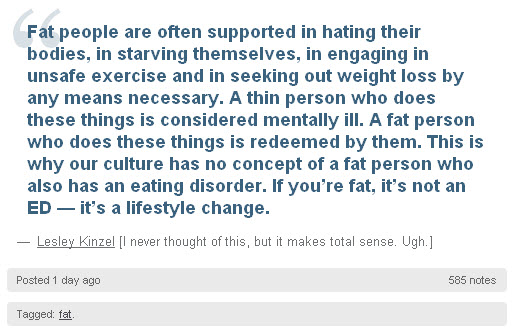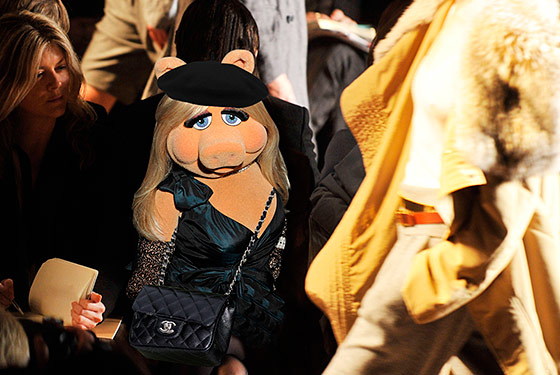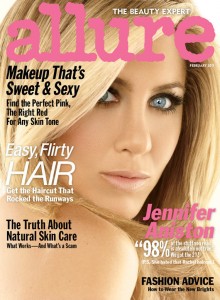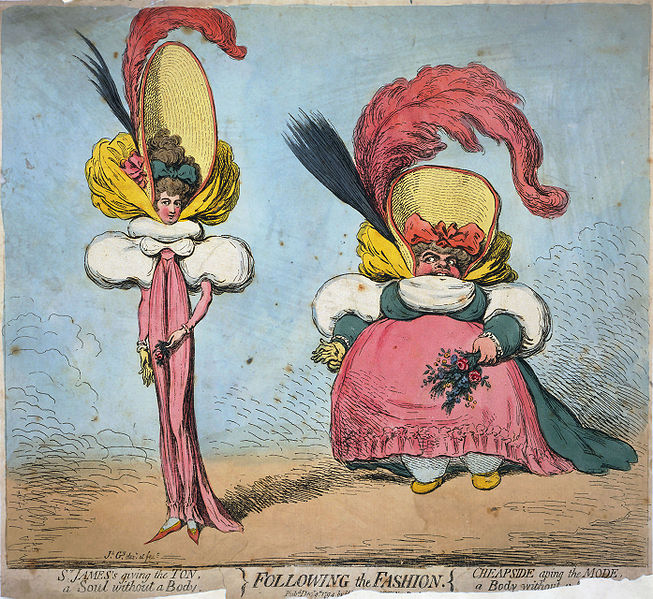[SATIRE] The USA in crisis: Unmasking the true threat to our national health.
By Lesley | January 28, 2011
Sadly, the United States is losing the international race to produce an immortal population. A new report from the US National Research Council has revealed that life expectancy in the US is rising more slowly than anticipated, and more slowly than other nations of similar circumstance around the world. Rising more slowly is basically the same thing as declining, as we all know. This is very important, mostly because it’s been a couple days since we had a reason to put the word “obesity” on the front page of a major news site.
Naturellement, the favored reason for our lagging behind the pack, appropriately like a fat asthmatic kid running laps in gym class, is our obesity. Also, to a lesser extent, our penchant for smoking. Although widespread acceptance of smoking has since been replaced by a totally reasonable rejection of smokers as evil cancer-spouting chimneys, annoyingly, Americans continue to die from smoking-related diseases, and are thereby dragging our proud nation down in the battle to defeat the inevitability of death. On the up side, now that smoking is only done by misanthropes, miscreants, and kickers of innocent puppies, the US life expectancy should go up a lot faster in the future. Which is good! Except no, there is no up side, because of the obesity epidemic, and that may or may not make us die sooner, possibly, if such things can be predicted, which they mostly can’t. Which is bad.*
Item the first:
This is old news in most corners of the internet by now, but I hadn’t mentioned it yet: in the new Muppet movie, due out in 2012, Miss Piggy will be employed as a plus size fashion editor for French Vogue. You know it’s a comedy, because French Vogue would never have need of a plus-size fashion editor. But I kid French Vogue. Piggy has received a bit of attention from the fashion world in recent years, being dressed by Marc Jacobs and turning up at Selfridge’s in Miu Miu, and even Lady Gaga has aped Piggy’s style. Considering Piggy was an early fashion influence for a great many fatshionistas, it’s nice to see her getting the recognition she deserves.
Yes, Miss Piggy is real. Shut up.
Today’s distraction comes to us from the Prelinger Collection at the Internet Archive, one of my favorite places on the web. I present a short 1951 discussion film entitled “The Outsider”. Susan Jane has what could be delicately referred to as social problems. Mainly she is convinced that all the kids at school hate her. Susan Jane is quiet, soft-spoken, painfully awkward, given to crying jags, and something of a proto-nerd. Her melodrama would be hilarious if it weren’t true that so many adolescent kids still go through the same damn issues.
Actually, it’s still hilarious, if only because this film is so dated. I am fascinated by the different words these kids stress in compound nouns: root beer, ice cream cone. Further, I really want to wear penny loafers with white socks all of sudden.
Susan Jane’s low self esteem leads to an unfortunate misunderstanding, which is ultimately resolved by one of the girls at school specifically going out of her way to make friends with her. Susan Jane then reads “a book on what to do to make people like you,” according to the narrator, and at the end of the film, leaves for the big party, where we can hope nobody dumps pig’s blood on her. Curiously, this short film could be interpreted to be carrying the message that it’s okay to be different, which is pretty unusual for what we expect of the uber-conformist 50s.
Also of interest in this short is incontrovertible proof that fat children existed even sixty years ago. This proof takes shape in the character of Junior, a tubby and cheerful boy who loves food and, interestingly, suffers none of Sarah Jane’s social problems, but is rather fully accepted by his friends.
Enjoy, my loves, and have a delicious weekend.
I have poked fun at Jennifer Aniston around here before, for apparently not knowing what a Cobb Salad is, though I am not as a rule anti-Aniston. I honestly don’t have a horse in that race. I’m pretty sure the only film I’ve ever seen her in was Office Space, which probably says something about my taste in movies. But generally I am apathetic on the Aniston front.
So it’s kind of unfortunate that this other little piece of lady-media daftness should also be connected to Aniston, but you know, some days you just have to laugh at shit. Aniston is on the cover of the February issue of Allure, and also in several partly-clothed pictures inside. This alone would not be of particular interest, except she’s been photoshopped so thoroughly that she looks like a RealDoll. For those in no-clicky environments, RealDolls are wildly expensive sex toys in the shape of full-sized human women, constructed and weighted to feel just like people, except, y’know, for being inanimate. Lest you think I am opposed to RealDolls, I am not. I figure if such a device serves a need, then have at it! But I do think something has gone awry when actual human women can be mistaken for dead-eyed silicone simulacra.
I mean, look:
The past few years have seen the rise of a new sort of celebrity. I blame Kirstie Alley for this, given her particularly memorable turn as Jenny Craig spokesperson, but she is only one of the many — Valerie Bertinelli, Sara Rue, Carnie Wilson, Jason Alexander — who have been famous in recent years primarily for having been on a diet. The latest casualty collected by the diet-spokesperson bandwagon is Carrie Fisher, of all people, who was evidently driven to take the job by mean-spirited internet commenters. I’ve started to wonder if someday soon I will turn on my television to see Miss Piggy singing the glories of Jenny Craig to the tune of “The Rainbow Connectionâ€.
The topic of today’s post is nearly as bad.
Jennifer Hudson has been shilling for Weight Watchers since the middle of 2010. Her new commercial campaign, predictably beginning with the new year, features a song known best to most folks today as a favorite of contestants on American Idol, or as something Michael Bublé sings. The song is “Feeling Goodâ€, and it first drew popular interest when it was recorded by Nina Simone.
Nina Simone did not write “Feeling Goodâ€, though her interpretation is probably the best-known version of it. “Feeling Good†is a song from Leslie Bricusse and Anthony Newley’s musical The Roar of the Greasepaint — The Smell of the Crowd, which came to the stage in 1965. The two main characters, Sir and Cocky, represent the upper and lower classes respectively. The story is told as a Vaudevillian allegory of British society, in which Sir and Cocky continuously play a vaguely-defined “game†for success in life. The set looks something like a giant tilted game board, and Cocky plays for food, employment, and love. Sir, as the wealthy and influential, controls and changes the rules of the game at will, while Cocky, as the working class, dutifully follows them. Unsurprisingly, Sir always seems to win the game while Cocky always loses. However, it is neither of these characters who sings what may be today’s best-known number from this little-known show.
“Following the Fashion”, a December 1794 caricature by James Gillray, which satirizes incipient neo-Classical trends in women’s clothing styles, particularly the trend towards what were known at the time as “short-bodied gowns” (i.e. short-bodiced or high-waisted dresses). This caricature satirizes the figure-type which is most flattered by high-waisted dresses, contrasting it with a body-type which was not flattered by the style…
Source: Wikimedia Commons
…Simplicity should be the style keynote for all stout people…
The woman who is stout should remember that solid colors always draw less attention to stoutness than checked, flowered and horizontally striped materials. She should wear over-blouses with her suit skirts instead of tucked-in waists, and they should be the same color as the suit itself. Her dresses should be made without waistlines, and the belts should always be narrow and tacked slightly lower than where the waist-line really should be.
For the woman who has large hips we recommend fullness of the material and a skirt that is worn an inch or two longer than the prevailing mode. The woman with broad shoulders should also wear clothes with plenty of fulness, for it is a mistaken idea that snug-fitting clothes hide stoutness. As a matter of fact, a tight dress instead of making a stout woman appear smaller, actually accentuates the size of the shoulders or hips.
Source: The New Way Course in Fashionable Clothes-Making (1926)
The stout woman should avoid the appearance of being too large for her clothes. The youthful styles should be left for the youthful figures. There are many becoming styles for the stout woman without making the figure conspicuous. The fronts, neck lines, lack of fullness in the skirt, good corseting, ease in fitting, all have a tendency to slenderize her figure. These should be desired rather than a pretty dress pattern that is attractive on the figure in the picture. Keep in mind, “Will I look attractive in that dress?”
Source: Home Sewing Course, by Helen Hall (1936)
It is interesting to know that most irregular size, stout women would not have abnormal flesh distribution if good posture had been maintained!
Source: Modern Pattern Design, by Harriet Pepin (1942)
…[W]e must choose our hats very much as our frocks are chosen. The short, stout figure should be made to appear taller; the tall, angular figure should be made to appear shorter and broader. It is as important that the hat suit the lines of the figure as it is for it to suit the lines of the face.
Source: The New-Way Course in Millinery and Hat Design (1928)
If the too-stout woman… wears the wrong kind of dress she looks even stouter than she really is. The same holds true with the short person, and the thin person. But all of us, whether we are tall or short, stout or slender, have some certain point of beauty—and it is our duty to see that the clothes we wear emphasize this “good point.”
Source:Â The New Way Course in Fashionable Clothes-Making (1926)
For as long as fashion has existed, women (and to a lesser extent, men) have been actively reshaping their bodies — first using corsetry, later via dieting — in the service of popular styles, while simultanously using various styles to visually reshape their bodies. We practice this superstitious fashion alchemy with the idea that we can fool others, or ourselves, into believing that the fantasy body we have inside our heads is our body in reality. Fact is, no matter what you put on it, a fat body looks fat. A thin body looks thin. And that’s not a bad thing.
Do you like stripes, or ruffles, or short skirts, or layers, or bodycon dresses? Wear them. Fuck all that well-meaning fashion advice: it’s arbitrary, often contradictory, always exhausting, and it doesn’t work. Whatever size you may be: wear what makes you feel good. You look fabulous when you feel fabulous. Be yourself and wear what you like. The only benefit to looking like everyone else is the ability to be ignored — and who wants that?
And stand the fuck up straight! You don’t want to suffer from “abnormal flesh distribution”, do you?
Hey kids! Today is my birthday. Because it’s my birthday, I’m going to ask that you indulge me in a small mental experiment.
Go to a window. It can be any window. It doesn’t have to be open; we will not be shouting today. Look outside. Do you see people? If you don’t see people, then turn on your television. Something newsy, if possible. Do you see people? Look at the people out your window or on your TV.
Now imagine every single one of them just dropping over dead.
Play along, kids. Imagine every single living human on this planet dropping over dead. I’m not creating a zombie apocalypse here; they won’t be getting up again. They’re all dead and you’re alone. You’re the last person left alive anywhere, in a world of corpses.
How’s your life going to change?
There are practical considerations. Nobody’d be coming round to pick up your trash at the curb, that’s for sure. Nobody’d be able to ring up your purchases at the grocery store, but then nobody’d be stocking the grocery store either. The guy who drives the subway train you take every morning? Gone. The neighbor who checks in on your cats when you go out of town? Expired. All of your Facebook friends? Permanently deleted. Your best friend? Passed on. Your whole family, your coworkers, anyone you ever loved? Ceased to be.
You’d have no one to talk to, in fact. It’d be dreadfully quiet.
Since it’s been a bit depress-o-rama around here this week, I thought I’d give us a little Friday fluff. The above short film was written and directed by Paco Farias, and stars Harvey Guillen, whom many of you will remember for his portrayal of the inimitable Alistair on the late lamented TV series Huge (which will be coming out on DVD in February). It’s every bit as precious as you’d expect. Enjoy, and have a marvelous weekend.
NB: Y’all know I never do trigger warnings, but since I know recovery can be a bitch, I am laying one out this time: this post discusses eating disorders and pro-ana/thinspiration.

The above paragraph from my post on Monday has been making the rounds on Tumblr.
I could have predicted it. Sometimes I think 90% of my writing is just packing peanuts cushioning one really solid and meaningful quote, and I have to write in all that other stuff to deliver the important bit in a single cohesive piece. Though I am hardly the first person to express the paradox described above, it makes me happy to see folks absorbing it and passing it along. This is one of those ideas that is invisible until the moment someone points it out to you. After that, it become obvious, inescapable; it cannot be unseen. It’s an a-ha moment, a click, a revelation. So it’s not a surprise to me that folks would respond to it.
And it’s not even a surprise, really, that it should also find its way onto a thinspiration or pro-anorexia feed. Or two, or more, by now, perhaps. For those unfamiliar with the notion, pro-anorexia (often shortened to pro-ana) is an ideology that believes eating disorders to be a legitimate lifestyle choice and not necessarily damaging. Though the shorthand specifies anorexia, it is generally applied to any eating-disordered behavior. Lazy thinkers will often attempt to link fat acceptance communities with pro-ana ones as equally irresponsible and dangerous movements. It might seem like a neat and tidy thing, to build a spectrum with extreme fatness and extreme thinness on either end, in a perfectly-balanced analogy. The problem is that anorexia (and other EDs) is a behavior, not a body type, and fat acceptance does not systematically advocate for overeating, which would be necessary for the analogy to work. That said, what pro-ana groups do share with fat acceptance communities is finding beauty in body shapes considered ugly by conventional standards, as well as a desire for full bodily autonomy, unrestrained by well-meaning interlopers. But there the similarities end.
If the comments to Monday’s post have revealed anything, it is that eating disorders are complex and convoluted, in spite of widespread assumptions about EDs being the exclusive province of skinny teenaged white girls from comfortable socio-economic backgrounds. These assumptions work to minimize the reality that most of us who grow up female in American culture will first learn disordered eating patterns far younger than we’d like to admit, and that this is a problem across race, class, gender, and age. It is a cultural problem. It is a social problem. It is a problem we all face, at one time or another, whether it happens to us or to someone we know.
Back in the early aughts, when I was still entertaining my aspirations to academia, I used to do campus talks and lectures on fat politics.* At least I’d try. Before IÂ learned classroom-management skills, things would get sidetracked, rapidly and dramatically. The usual culprit? A skinny girl either suffering from or in recovery for an eating disorder.
Now don’t fret! I am not dissing skinny girls with eating disorders. I have a great many of you as readers and I am constantly humbled and pleased that you glean something of value from what I write here. But my conundrum in this particular circumstance was that I was not giving a talk on eating disorders — I was giving a talk on fat. Though they can be related, these subjects are distinct and separate, especially in an academic context. So when I’d get halfway through my talk about fatness (and the lack thereof) in popular media, and someone in the room would raise her hand and start disclosing about her ED, I’d get a little deer-in-the-headlights about it. How do I redirect this conversation without dismissing this woman’s experience, and her desire to share it? That is important, and good! We should talk about eating disorders and body image issues freely and without shame! I wanted to support the ED folks without allowing that subject to dominate the discussion, which was supposed to be about fat.
Eventually I learned the technique of redirecting without dismissing. I even figured out how to acknowledge that, while your eating disorder is a valid subject, being fat is a seriously different animal from being not-fat but having an ED. As is being fat and having an ED at the same time. The experience of feeling fat, and hating your body, may share aspects in common with actually being fat. But being fat brings with it a whole bunch of other baggage that a non-fat person really can’t get. It’s one thing to look in the mirror and see yourself as a huge and hideous monster. It’s another thing to fear going out to eat because you’re not sure if you’ll fit in the booth with your friends. Both are tragic. But they are different.









 Two Whole Cakes is a blog written by
Two Whole Cakes is a blog written by 

